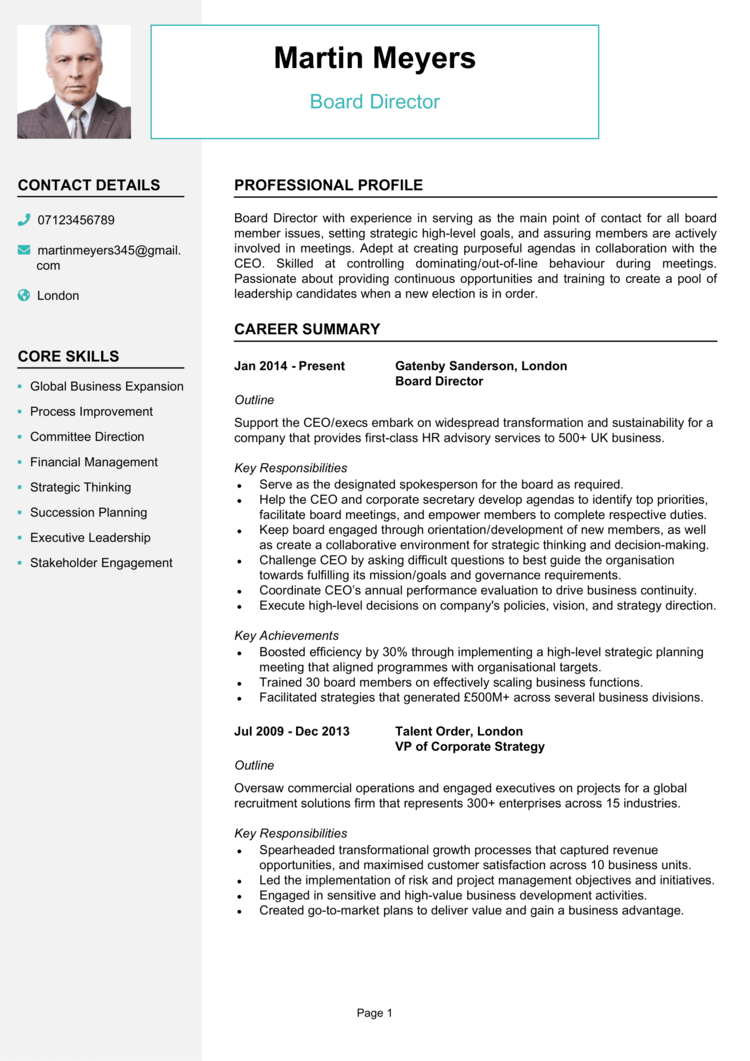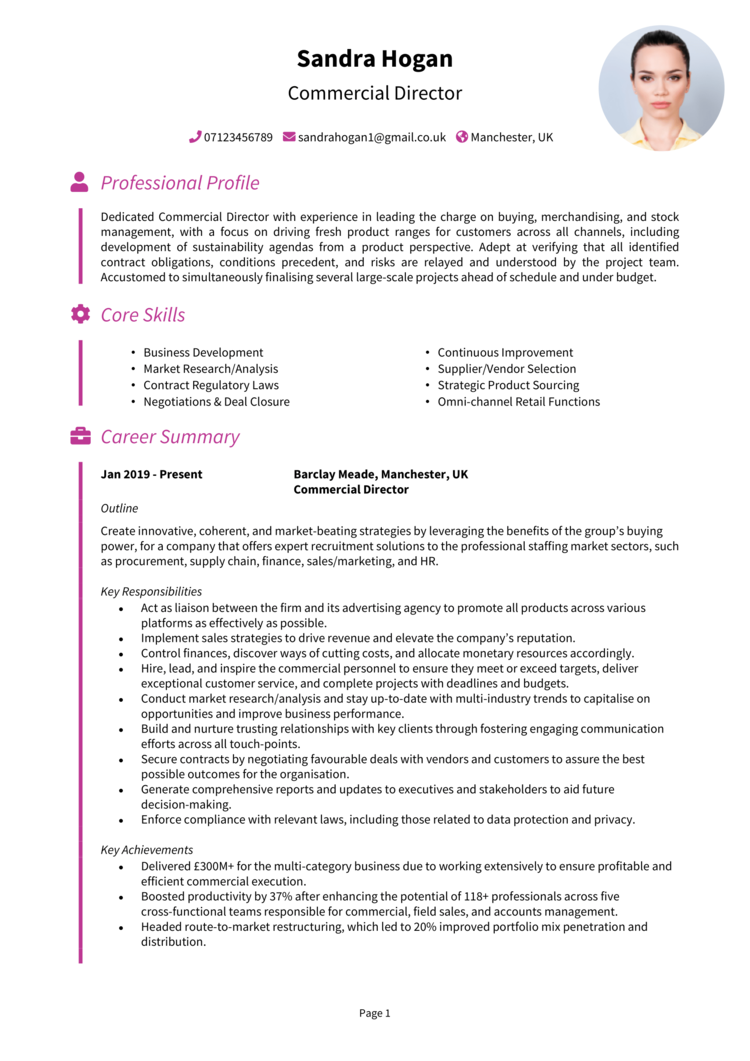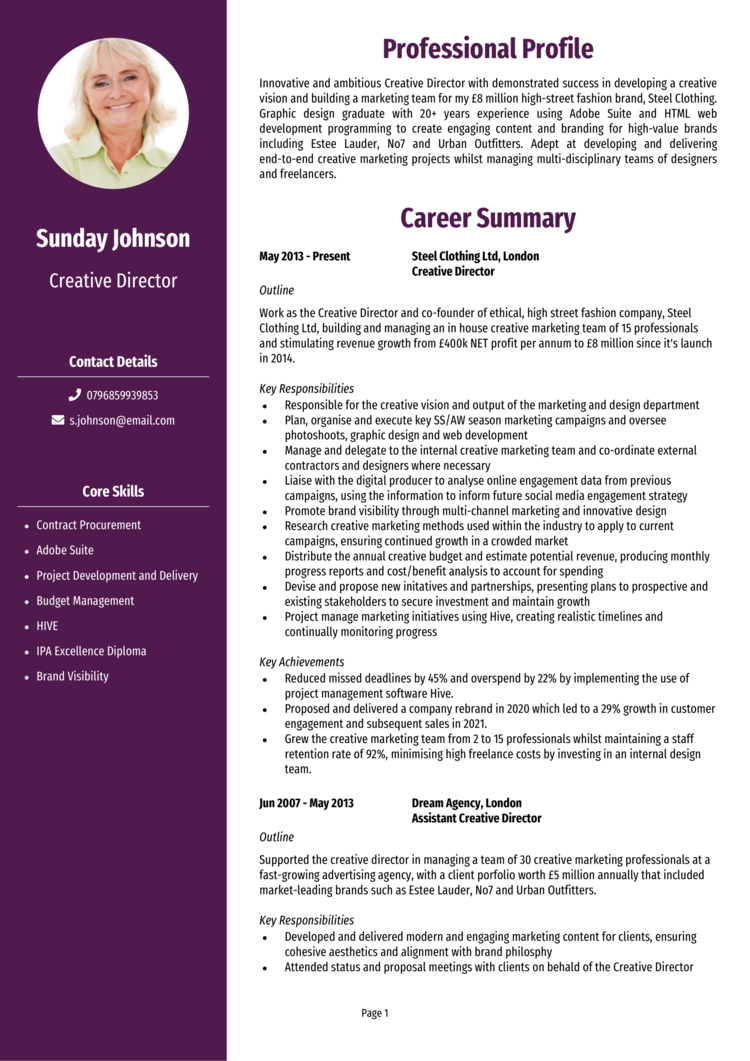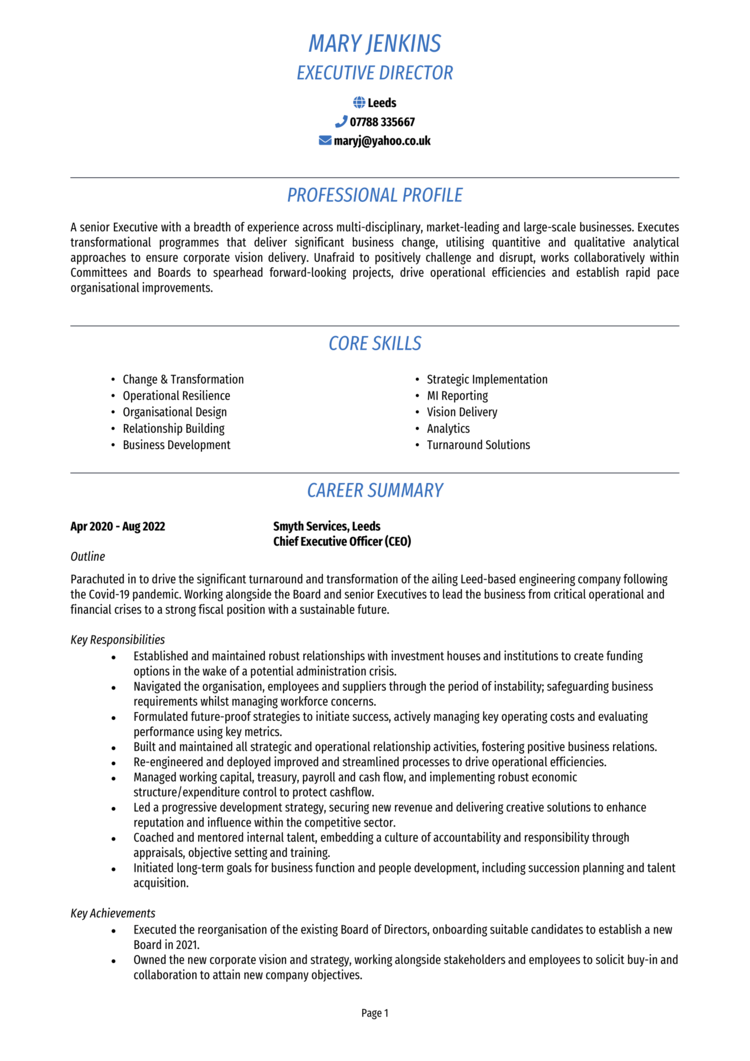As the driving force behind business strategy and success, you’ll face difficult competition in the senior role of managing director.
To stand out and take the helm of your next company, you’ll need a CV that reflects your executive prowess.
This guide and its Managing Director CV examples will walk you through how to convince hiring managers that giving you the reins would benefit their company, opening up rewarding opportunities for you.
Managing Director CV example

Board Director CV example

Commercial Director CV example

Creative Director CV example

Executive Director CV example

Director CV example

How to write your Managing Director CV
Learn how to create your own interview-winning Managing Director CV with this simple step-by-step guide.
A successful company runs on clear strategy, strong leadership, and decisive action – your CV should embody those same qualities. A generic, unfocused application won’t get you far, but a well-crafted one? That’s your opportunity to stand out in a competitive executive market.
Whether you’ve scaled businesses, turned around struggling divisions, or expanded into new markets, this guide will show you how to write a CV in a way that demands attention.
Managing Director CV structure


A solid CV structure ensures that employers can quickly assess your leadership credentials, strategic expertise, and commercial impact. A cluttered mess will not only make a bad impression, but make finding those key details difficult.
Here’s the layout to follow:
- Name and contact details – Display your contact details clearly at the top so employers can get in touch easily. Including a photo is entirely optional.
- Profile – Begin with a concise summary that highlights your expertise and what you bring to the role, from strategic vision to business success.
- Core skills – Highlight your strongest skills, such as financial management and leadership, that align with the role’s requirements.
- Work experience – Go through a structured list of previous leadership roles, focusing on commercial impact, revenue growth, and transformation projects.
- Education – Mention your degrees, certifications, and any training that supports your career path.
- Additional info – Include any additional details, like industry awards, hobbies, or memberships, that highlight your skills or personality.
Managing Director CV format


A CV that reads more like a bloated quarterly report is unlikely to inspire much confidence. The content itself is already impressive, but it’ll be lost on recruiters if you make the mistake of an unreadable format.
Here’s some useful tips to keep your formatting perfect:
- Bullet points – These help recruiters skim through your accomplishments quickly and easily.
- Divide sections – Break your CV into distinct sections with clear headings for smooth navigation.
- Use a clear and readable font – Use a simple, professional font and keep your layout uncluttered for maximum readability.
- No more than 2 pages – This is enough length to highlight your expertise while keeping the recruiter interested.
The best way to write a Managing Director CV profile


Your CV profile needs to establish your leadership credentials and strategic impact within seconds. It’s the first thing recruiters are going to see, so make sure it hooks them fast: give a snappy overview of your skills, experience, and the value you’d bring leading any company.
Managing Director CV profile examples
Profile 1
Strategic and results-driven Managing Director with over six years of experience leading business operations, driving revenue growth, and implementing effective leadership strategies. Skilled in corporate governance, financial planning, and stakeholder management. Adept at optimising operational efficiency, developing high-performing teams, and expanding market reach. Committed to delivering long-term business success and sustainable growth.
Profile 2
Experienced Managing Director with five years of expertise in overseeing multi-functional teams, managing company finances, and setting strategic business goals. Adept at business development, mergers and acquisitions, and risk management. Skilled in financial forecasting, market expansion, and brand positioning. Passionate about driving innovation and ensuring long-term profitability.
Profile 3
Dynamic and visionary Managing Director with over ten years of expertise in leading organisations to achieve operational excellence and financial success. Skilled in strategic planning, corporate restructuring, and high-level negotiations. Proficient in driving international expansion, improving stakeholder engagement, and executing large-scale business transformation projects. Dedicated to fostering a culture of innovation and sustainable business growth.
What to include in your Managing Director CV profile
This is what you should try to include:
- Executive experience – Highlight your years in leadership roles, from MD to C-suite positions.
- Strategic vision – Showcase your ability to shape company direction, drive innovation, and lead transformation.
- Financial impact – Demonstrate how you’ve increased revenue, optimised budgets, or led mergers and acquisitions.
- Leadership and team building – Mention how you’ve built and managed high-performing teams.
- Operational excellence – If you’ve streamlined processes, improved efficiencies, or driven cultural change, include it here.
Core skills section


Leadership at the highest level demands a combination of commercial insight, strategic execution, and stakeholder management.
Your core skills section should bullet point the things you want to leap out to recruiters when they first open up your application. Tailor them to highlight the skills that best match the company’s needs.
Top skills for your Managing Director CV
- Business Strategy Development – Defining and implementing long-term strategic plans to drive company growth and profitability.
- Financial Oversight and Budgeting – Managing company finances, setting budgets, and ensuring financial sustainability.
- Leadership and Team Management – Leading executives and employees to align with business objectives and foster a strong corporate culture.
- Market Analysis and Competitive Positioning – Assessing industry trends, market opportunities, and competitor strategies to maintain a competitive edge.
- Operational Efficiency and Process Optimisation – Streamlining workflows and improving business processes for maximum productivity.
- Risk Management and Compliance – Identifying potential risks and ensuring adherence to legal, regulatory, and corporate governance standards.
- Stakeholder and Investor Relations – Managing relationships with shareholders, board members, investors, and key business partners.
- Business Development and Expansion – Identifying growth opportunities, acquisitions, and partnerships to expand market presence.
- Crisis Management and Decision-Making – Navigating challenges, making high-impact decisions, and ensuring business continuity during crises.
- Corporate Social Responsibility (CSR) and Brand Reputation – Upholding ethical business practices and enhancing the company’s public image.
Showcasing your work experience


Employers want to see how and where you’ve put your impressive leadership skills to good use. They want to see the businesses you’ve led, the strategic decisions you’ve made, and the tangible outcomes you’ve delivered.
Start with your most recent work experience and work backwards. If you’re stepping up to a Managing Director position for the first time, focus on your most senior leadership roles and the strategic contributions you’ve made in those positions. The key is to show how your decision-making has shaped business success.
How to structure jobs

- Outline – Mention the company, your role, and the scale of the business (e.g., revenue, number of employees, market presence).
- Responsibilities – Bullet point key leadership duties, such as business growth strategy, financial oversight, or stakeholder engagement. Use action words like “spearheaded”, “orchestrated”, and “optimised”.
- Achievements – Walk through measurable results, such as profit growth, market expansion, or cost savings. Use quantifiable data where possible.
Example work history for Managing Director
Managing Director | Summit Enterprises Ltd
Outline
Provided executive leadership at a multinational corporation, overseeing all business operations, financial planning, and strategic growth initiatives to drive long-term success.
Responsibilities
- Developed and executed long-term business strategies, aligning company goals with market trends.
- Led and mentored senior leadership teams, ensuring alignment with company objectives.
- Managed financial planning, budgeting, and risk assessment to drive profitability.
- Oversaw mergers, acquisitions, and business expansion into new markets.
- Built and maintained relationships with key stakeholders, investors, and regulatory bodies.
Achievements
- Increased annual revenue by 40 percent through strategic business development initiatives.
- Successfully led a corporate restructuring programme that improved operational efficiency by 25 percent.
- Expanded business operations into three new international markets, boosting company valuation.
Managing Director | OmniTech Solutions
Outline
Led company-wide operations for a technology firm, driving growth, innovation, and financial performance through strategic planning and market expansion.
Responsibilities
- Developed and implemented strategic plans to enhance market presence and competitiveness.
- Oversaw product development and digital transformation initiatives, ensuring alignment with customer needs.
- Managed financial performance, optimising costs and maximising revenue growth.
- Engaged with board members and investors to secure funding and strategic partnerships.
- Ensured compliance with corporate governance and industry regulations.
Achievements
- Increased market share by 35 percent through targeted growth strategies.
- Led a successful digital transformation project that improved operational efficiency by 30 percent.
- Recognised for implementing a customer-focused approach that increased client retention rates.
Managing Director | Pinnacle Retail
Outline
Directed business strategy and team management at a national retail organisation, overseeing revenue growth, operational efficiency, and customer engagement initiatives.
Responsibilities
- Developed and executed business plans, ensuring company growth and financial stability.
- Led a team of senior managers across multiple departments, optimising performance and efficiency.
- Analysed market trends to adapt strategies for evolving consumer demands.
- Negotiated contracts with suppliers, partners, and key business stakeholders.
- Oversaw branding and marketing strategies to strengthen market position.
Achievements
- Grew company revenue by £10M through expansion into new product categories.
- Reduced operational costs by 20 percent through strategic procurement and process improvements.
- Led the launch of an e-commerce platform, increasing online sales by 50 percent.
How to write your education section


Typically, work experience is prioritised more highly than education history: management roles are certainly no different. As such, you should keep your list of qualifications relatively brief: just list any degrees in business, finance, or management, as well as executive leadership programs or specialist training that supports your expertise.
Key qualifications for a Managing Director
- MBA (Master of Business Administration) – A strong foundation for executive leadership and strategic decision-making.
- Chartered Director Qualification (CDir) – Recognised for board-level leadership.
- Financial Management Certification (e.g., CFA, CIMA, ACCA) – Useful for MDs overseeing financial strategy.
- Leadership & Strategy Training (e.g., Harvard Business School Executive Education, INSEAD Leadership Programs) – Demonstrates executive development.
- Corporate Governance Training – Essential for MDs working with boards and stakeholders.




